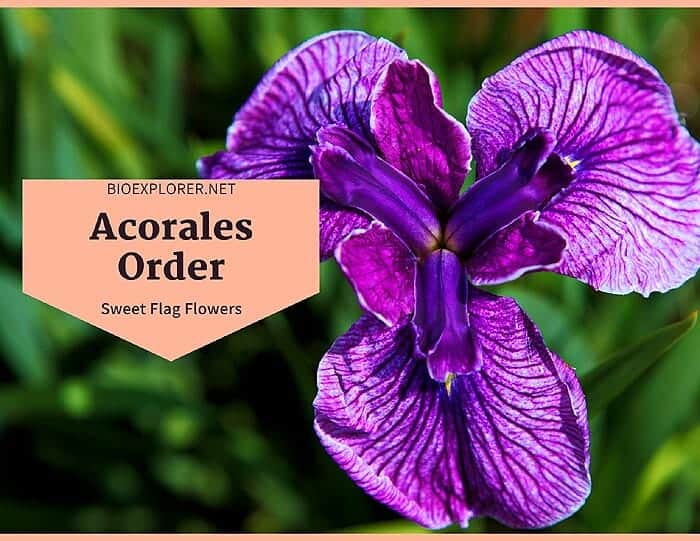
Acorales, commonly called the sweet flag order of flowering plants, is considered the most basal lineage of monocotyledons (monocots). There is only one family in this order called Acoraceae and one genus, Acorus divided into two to four plant species that resemble Irises.
Table of Contents
Acorales Pronunciation
Acorales Distribution

Acoraceae – Sweet Flag family.
The Acoraceae plants are perennial herbs that grow in marshy habitats. The members of this family are commonly found in the Old World and North America.
- Acorus calamus(sweet flag) grows in the wetlands of North America and from India to Indonesia. The other species of this family are distributed in the temperate regions of Asia and Europe, found mostly around ponds and along streams.
![]()
Acorales Characteristics

Some characteristics of the Acorales order in general are:
- Rhizomatous stems
- Leaves that are: EnsiformWhat is Ensiform?Sword-shaped., unifacial, distichousWhat is distichous?Two-ranked, with leaves or flowers in two opposite rows in the same plane., sheathing, simple, undivided, exstipulateWhat is exstipulate?Without stipules; Stipule is a small structure of appendage found at the base of some leaf petioles., and parallel-veined, with intravaginal (axillary) squamulesWhat is squamules?A small loosely attached lobe in a squamulose lichen. present.
- The inflorescence can be described as a terminal spadix borne on a peduncle resembling a leaf, subtended by a long spathe.
- The flowers are bisexual, actinomorphic, ebracteate, sessile, and hypogynous.
- A biseriate perianth has 3+3 distinct tepals.
- Biseriate stamens that are 3+3, apostemonous, and have flattened filaments.
- Longitudinal anthers
- The gynoecium is syncarpousWhat is syncarpous?Having united carpels. Contrast apocarpous., with a superior ovary, 2-3 carpels, 2-3 locules, and a minute stigma. apical-axile Placentation; ovules are ∞ per carpel.
- The fruit is a 1-5[-9] seeded berry, with a persistent perianth.
- The seeds are endospermousWhat is endospermous?An embryonic nutritive tissue formed during double fertilization by the fusion of a sperm with the polar nuclei. and perispermousWhat is perispermous?A food reserve tissue found in the seeds of plants such as coffee, beets, or spinach. It is formed outside the embroyo sac..
- Aromatic ethereal oil cells make the flowers fragrant.
- Raphide crystals are not present.
![]()
How are Acoraceae similar to the family Araceae?
The Acoraceae were previously placed under the family Araceae because they are pretty similar. Plants from both families have a spadix and spathe. Still, the Acoraceae are classified as a distinct family based on differences in morphology and DNA sequence.
The following features of Acoraceae make it different from Araceae:
- EnsiformWhat is Ensiform?Sword-shaped., unifacial leaves
- endospermous seeds
- aromatic (ethereal) oil cells.
- Absence of raphide crystals.
![]()
Acorales Example Species

- Acorus calamus- is an herbal ingredient used almost since the Classical Greek era.
- Calamusand A. gramineus- are cultivatedas garden ornamentals.
![]()











